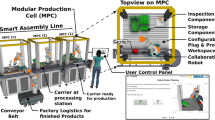Abstract
During the conceptual and prototype design stage of an industrial product, it is crucial to take assembly/disassembly and maintenance operations in advance. A well-designed system should enable relatively easy access of operating manipulators in the constrained environment and reduce musculoskeletal disorder risks for those manual handling operations. Trajectory planning comes up as an important issue for those assembly and maintenance operations under a constrained environment, since it determines the accessibility and the other ergonomics issues, such as muscle effort and its related fatigue. In this paper, a customer-oriented interactive approach is proposed to partially solve ergonomic related issues encountered during the design stage under a constrained system for the operator’s convenience. Based on a single objective optimization method, trajectory planning for different operators could be generated automatically. Meanwhile, a motion capture based method assists the operator to guide the trajectory planning interactively when either a local minimum is encountered within the single objective optimization or the operator prefers guiding the virtual human manually. Besides that, a physical engine is integrated into this approach to provide physically realistic simulation in real time manner, so that collision free path and related dynamic information could be computed to determine further muscle fatigue and accessibility of a product design.
Similar content being viewed by others
References
Smith B., Marler T., Abdel-Malek K.: Studying visibility as a constraint and as an objective for posture prediction. SAE Int. J. Passenger Cars Mech. Syst. 1, 1118–1124 (2009)
Li K., Duffy V., Zheng L.: Universal accessibility assessments through virtual interactive design. Int. J. Hum. Factors Modell. Simul. 1, 52–68 (2006)
Rajan V., Sivasubramanian K., Fernandez J.: Accessibility and ergonomic analysis of assembly product and jig designs. Int. J. Ind. Ergon. 23, 473–487 (1999)
Maille, B., Chedmail, P., Ramstein, E.: Emergence of a virtual human behaviour in a virtual environment. IDMME, Clermont-Ferrand, France, Mai (2002)
Rennuit, A., Micaelli, A., Merlhiot, X., Andriot, C., Guillaume, F., Chevassus, N., Chablat, D., Chedmail, P.: Passive control architecture for virtual humans. In: International Conference on Intelligent Robots and Systems, Edmontgon, Canada (2005)
Lavalle S.M.: Planning algorithm. Cambridge University Press, Cambridge (2006)
Pontonnier C., Dumont G.: Inverse dynamics method using optimization techniques for the estimation of muscles forces involved in the elbow motion. Int. J. Interact. Des. Manuf. 3, 227–236 (2009)
Grag D.P., Kumar M.: Optimization techniques applied to multiple manipulators for path planning and torque minimization. Eng. Appl. Artif. Intell. 15, 241–252 (2002)
Min G.C., Jehee L., Sung YS.: Planning biped locomotion using motion capture data and probabilistic roadmaps. J. ACM Trans. Graph. 22, 1–25 (2003)
Lacob R., Mitrouchev P., Léon J.C.: Contact identification for assembly–disassembly simulation with a haptic device. Visual Comput. 24, 973–979 (2008)
Khalil W., Dombre E.: Modelling, Identification and control of robots. Hermes Science Publications, Paris (2002)
Ma L., Ma R., Chablat D., Bennis F.: Using virtual human for an interactive customer-oriented constrained environment design. IDMME / Virtual Concept, Bordeaux, France (2010)
Chedmail P., Chablat D., Roy C.L.: A distributed approach for access and visibility task with a manikin and a robot in a virtual reality environment. IEEE Trans. Ind. Electron. 50, 692–698 (2003)
Masih-Tehrani B., Janabi-Sharifi F.: Kinematic modeling and analysis of the human workspace for visual perceptibility. Int. J. Ind. Ergon. 38, 73–89 (2008)
McAtamney L., Corlett E.N.: RULA: a survey method for the investigation of work-related upper limb disorders. Appl. Ergon. 24, 91–99 (1993)
Ma L., Chablat D., Bennis F., Zhang W.: A new simple dynamic muscle fatigue model and its validation. Int. J. Ind. Ergon. 39, 211–220 (2009)
Ma L., Zhang W., Fu H., Guo Y., Chablat D., Bennis F.: A framework for interactive work design based on motion tracking, simulation, and analysis. Hum. Factors Ergon. Manuf. Serv. Ind. 20, 339–352 (2010)
Liu J., Brown R., Yue G.: A dynamical model of muscle activation, fatigue, and recovery. Biophys. J. 82, 2344–2359 (2002)
Author information
Authors and Affiliations
Corresponding author
Rights and permissions
About this article
Cite this article
Ma, L., Ma, R., Chablat, D. et al. Human arm simulation for interactive constrained environment design. Int J Interact Des Manuf 7, 27–36 (2013). https://doi.org/10.1007/s12008-012-0162-z
Received:
Accepted:
Published:
Issue Date:
DOI: https://doi.org/10.1007/s12008-012-0162-z




